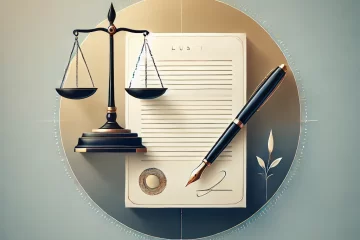![]()
Introduction
There are several situations in business where you may need to communicate confidential information with another party. However, the essential to doing so properly is ensuring that another party is obligated to treat the personal information you tell them with care and not to use it against you.
A Non-Disclosure Agreement, often known as a “Confidentiality Agreement” or “NDA,” is a popular way to maintain the confidentiality of secret information entrusted to another party.
In this article first a general understanding towards non-disclosure agreements is provided which will give reader the insight for what it is? And how is make sense? Then going into deeper details, the elements are discussed with the discussion of confidentiality in non-disclosure agreements. Last part deals with provisions which relates to this privacy and information protecting non-disclosure agreement.
In what ways does a non-disclosure agreement task effectively?
A non-disclosure agreement (hereinafter referred to NDA) as is a legally enforceable contract that creates a confidentiality connection between two parties. The signatory party or parties acknowledge that every sensitive data they collect would not be shared with anyone else.[1] Another name for a non-disclosure agreement (NDA) is a confidentiality agreement.
NDA are frequently used by businesses when negotiating with other businesses. They make it possible for parties to transmit sensitive data without danger of it falling into the wrong hands of competitors.[2] It’s termed a consensual NDA in this scenario.
Usefulness of Non-Disclosure Agreement
An NDA should only be required when it makes total sense agree upon it. Surely, there seem to be numerous situations where it would have been acceptable. This is especially true in cases where another party is pilfering your information or share it without your consent, and you just want to guarantee that they don’t do so.[3]
Following are few situations where one might feel that NDA makes true sense:
- Where you share you invention or business concept presentation.
- Where prospective buyers of your firm may be interested in knowing your fiscal, branding, as well as other company data.
- Where prospective purchasers and licensees are shown a new type of software
- Where you are getting someone’s services who may steal confidential information in the course of delivering his/her services.
The Key Elements of Non-Disclosure Agreements
Not all non-disclosure agreements are extensive and complicated.[4] Even the best ones are generally only few pages long.
The key elements of NDA[5]:
- Identification of the parties
- Definition of what is deemed to be confidential
- The significant degree of either the receiving party’s secrecy obligation
- The exclusions from confidential treatment
- The term of the agreement
What is Confidential Information?
Confidential information is defined underneath this portion. There’s no way to tell. Does it is some information that is labelled as “confidential” mostly in text? What happens when it comes to oral communication, can it be considered confidential?
It had been decided to use an objective basis based on the anticipations of reasonable men.[6] As a result of Thomas Marshall (Exports) Ltd. v. Guinle[7], where the plaintiff requested an injunction towards the Managing Director who had set up a competitive firm, there is now a subjective aspect involved. The court said that whenever a person has a reasonable suspicion that releasing information will damage him, and the material is not in the public sphere, it becomes secret. The owner’s beliefs must be taken into consideration when evaluating whether material is secret, as a result of this.
As a result of these rulings, the House of Lords affirmed in the Spy Catcher case[8] that material must not be of public realm which ought to be kept private.
To be clear, the judgement is not on question as to whether or not the foregoing logic would allow someone who has a secret piece of information to escape the requirement of confidentiality by disclosing that information. According to Lord Goff, a 3rd party’s revelation needs not relieve a confidant of such responsibilities. As long as the judges are unwilling to enable a confidant to profit from a violation of trust, secret information is not to be made available public.[9] To be sure, if the information is disclosed by the person who has access to it, there will be no case for breach of confidence.[10] It’s possible that a gap in duration will lead to a breach of confidentiality.[11]
When it comes to confidentiality, one side is trying it to be really inclusive as possible so that they don’t have to worry about someone finding a vacuum and stealing their important secrets.
For those who receive information, there is a reasonable need to ensure that the information is properly labelled so that they know what they may and cannot do with it.
It might even be troublesome with oral information in general and especially. Others think that only written material must be kept secret. It is possible that the person who is providing the oral information will claim that this is too limited. Across the other hand, the revealing party must affirm in written that oral comments are secret to the other party immediately after revealing them, whilst the recipient is aware about what oral statements are considered confidential.
Mutual vs. Non-Mutual NDAs
NDA are categorized into two kinds: mutual and one-sided agreements. Whenever you consider a one-sided agreement, you’re thinking about just one side exchanging confidential information with another. The mutual NDA form is used in instances where both parties may exchange secret information.[12]
Though there will always be some attraction to adopting a mutual form of NDA, one can generally avoid it if one not expecting private information from the other side. One method to make this decision earlier than usual is to advise the other party that you do not want to get any one of their sensitive information and therefore do not have a need for a mutual form if they request one.
Provisions Relating to the NDA
Depending on the circumstances, you may want to include some more alarms and whistles to your NDA to safeguard your organization from potential problems. Here are some suggestions:
Solicitation of employees: If the recipient has considerable accessibility to your personnel, include a condition prohibiting the recipient from recruiting or employing your staff for a period of 12 to 24 months. With some exceptions, the other party may occasionally consent to that. For example, the recipient may seek to limit the restriction only to those employees with whom they have had interaction during their examination of data or interviews.[13]
In the event of a disagreement, who has jurisdiction: If you’re the disclosing party, you’ll want to make absolutely sure that any disagreements about whether another party has met its duties will be resolved solely in your city. You don’t want to have to go a long distance and pay extra fees to implement your NDA.[14]
Injunctive relief: Make sure there’s a clause in the contract that allows you the authority to injunctive remedy if the other party breaks it. This clause basically states that you can obtain a court order preventing the other party from performing the breaching act (rather than only seeking compensatory damages after it is too late).
The receiving party has no rights: It’s occasionally useful to include a language that states that simply because you’re going to share sensitive information with them, they don’t gain any ownership to your concepts or even the ability to do business with you.
Conclusion
Finally, there are indeed a variety of circumstances in which a confidentiality agreement is suitable and might even be presented. Understanding a few fundamental aspects about confidentiality agreements would help guarantee that the essential goals they serve are not jeopardized by ambiguities or misunderstandings of the language used in the agreement.
They should be used in a structured approach to disclosures that incorporates other measures to make sure that you would get the maximum suited safeguards. Always use a contract signed into law by a knowledgeable intellectual property lawyer.
References:
[1] Henry Pharr III, Confidentiality and Non-Disclosure Clauses in Commercial Contracts – Is it worth the Effort?, Real Estate Drill Down (MARCH 17, 2016), https://web.archive.org/web/20180826122959/https://realestatedrilldown.com/2016/03/17/confidentiality-and-non-disclosure-clauses-in-commercial-contracts-is-it-worth-the-effort/.
[2] GOV.UK, https://www.gov.uk/government/publications/non-disclosure-agreements/non-disclosure-agreements (last visited Sept. 13, 20021).
[3] Richard Harroch, The Key Elements of Non-Disclosure Agreements, Forbes (Mar 10, 2016,11:45am), https://www.forbes.com/sites/allbusiness/2016/03/10/the-key-elements-of-non-disclosure-agreements/?sh=6e25e2c9627d.
[4] Sloan Brothers, Intellectual Property: Using Confidentiality Agreements, Yahoo! Small Business, https://web.archive.org/web/20090323220129/http://smallbusiness.yahoo.com/r-article-a-57763-m-4-sc-25-intellectual_property_using_confidentiality_agreements-i.
[5] Iowa State University, https://www.extension.iastate.edu/agdm/wholefarm/html/c5-80.html (last visited Sept. 13, 20021).
[6] Holyoak, J. & Torremans, Paul: Intellectual Property Law 384 (1st ed. 1995).
[7] (1978) 3 All ER 193.
[8] Attorney General v. Guardian Newspapers, (1988) 3 All ER 545.
[9] Holyoak, J. & Torremans, Paul: Intellectual Property Law 384 (1st ed. 1995).
[10] Mustad & Son v. Dosen, (1963) 3 All ER 416.
[11] Attorney General v. Jonathan Cape Ltd., (1975) 3 All ER 484.
[12] David V. Radack, Understanding Confidentiality Agreements, JOM, https://www.tms.org/pubs/journals/JOM/matters/matters-9405.html.
[13] Richard Harroch, The Key Elements of Non-Disclosure Agreements, Forbes (Mar 10, 2016,11:45am), https://www.forbes.com/sites/allbusiness/2016/03/10/the-key-elements-of-non-disclosure-agreements/?sh=6e25e2c9627d.
[14] Alexandra Twin, Non-Disclosure Agreement (NDA), Investopedia (January 03, 2021), https://www.investopedia.com/terms/n/nda.asp.



0 Comments